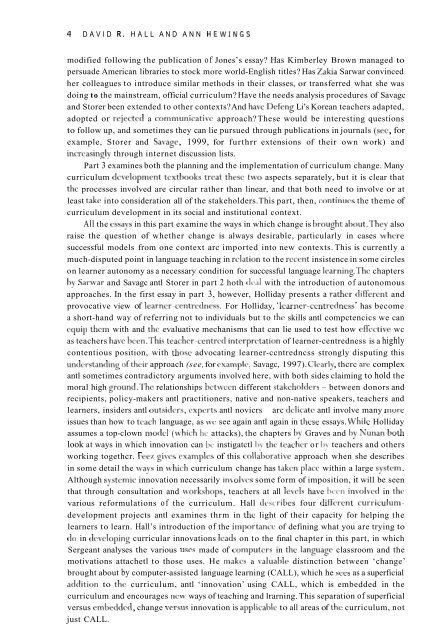Download - Search
Download - Search
Download - Search
Create successful ePaper yourself
Turn your PDF publications into a flip-book with our unique Google optimized e-Paper software.
4 DAVID R. HALL AND ANN HEWINGSmodified following the publication of Jones’s essay? Has Kimberley Brown managed topersuade American libraries to stock more world-English titles? Has Zakia Sarwar convincedher colleagues to introduce similar methods in their classes, or transferred what she wasdoing to the mainstream, official curriculum? Have the needs analysis procedures of Savagcand Storer been extended to other contexts? And have Defeng Li’s Korean teachers adapted,adopted or rejectcd a communicative approach? These would be interesting questionsto follow up, and sometimes they can lie pursued through publications in journals (see, forexample, Storer and Savage, 1999, for furthrr extensions of their own work) andincrcasingly through internet discussion lists.Part 3 examines both the planning and the implementation of curriculum change. Manycurriculum dcvelopment tcxtbooks treat these two aspects separately, but it is clear thatthe processes involved are circular rather than linear, and that both need to involve or atleast take into consideration all of the stakeholders. This part, then, continucs the theme ofcurriculum development in its social and institutional context.All the essays in this part examine the ways in which change is brought about.They alsoraise the question of whether change is always desirable, particularly in cases wheresuccessful models from one context arc imported into new contexts. This is currently amuch-disputed point in language teaching in rclation to the recent insistence in some circleson learner autonomy as a necessary condition for successful language learning.Thc chaptersIiy Sarwar and Savagc antl Storer in part 2 hoth deal with the introduction of autonomousapproaches. In the first essay in part 3, however, Holliday presents a rather differcnt andprovocative view of learner~centrcdness. For Holliday, ‘learner-centredncss’ has becomea short-hand way of referring not to individuals but to thc skills antl compctencics we canequip thcm with and thc evaluative mechanisms that can lie used to test how effective wcas teachers have bcxn.This teachcr-centred interprctation of learner-centredness is a highlycontentious position, with those advocating learner-ccntredncss strongly disputing thisunderstanding oftheir approach (see, for cxamplc, Savagc, 1997). Clcarly, thcrc arr complexantl sometimes contradictory arguments involved here, with both sides claiming to hold themoral high ground.Thc relationships lxtwccn different stakeholtlers ~ between donors andrecipients, policy-makers antl practitioners, native and non-native speakers, teachers andlearners, insiders antl outsiders, cxpcrts antl novicrs arc dclicatc antl involve many moreissues than how to tcach language, as \vc see again antl again in these essays. While Hollidayassumes a top-clown model (Lvhich he attacks), the chapters by Graves and liy Nunan 110thlook at ways in which innovation can be instigatctl by the teachcr or by teachers and othersworking togethcr. Feez givcs cxamplrs of this collalxxative approach when she describesin some detail the \vays in irhich curriculum change has taken place within a large systcm.Although systcmic innovation necessarily in\ olvcs some form of imposition, it will be seenthat through consultation and Lrorkshops, teachers at all levcls have been involvctl in thcvarious reformulations of the curriculum. Hall tlc ribes four tliffercnt curriculumdevelopmentprojects antl examines thrm in thc light of their capacity for helping thelearners to learn. Hall’s introduction of the irnportancc of defining what you are trying todo in tlcvcloping curricular innovations leads on to the final chapter in this part, in whichSergeant analyses the various uses made of computcrs in the language classroom and themotivations attachetl to those uses. He makes a va1ual)le distinction between ‘change’brought about by computer-assisted language learning (CALL), which he sees as a superficialaddition to the curriculum, antl ‘innovation’ using CALL, which is embedded in thecurriculum and encourages new ways of teaching and lrarning. This separation of superficialversus embeddcd, change versus innovation is applicablc to all areas of the curriculum, notjust CALL.


